Title
Content
Title
Content
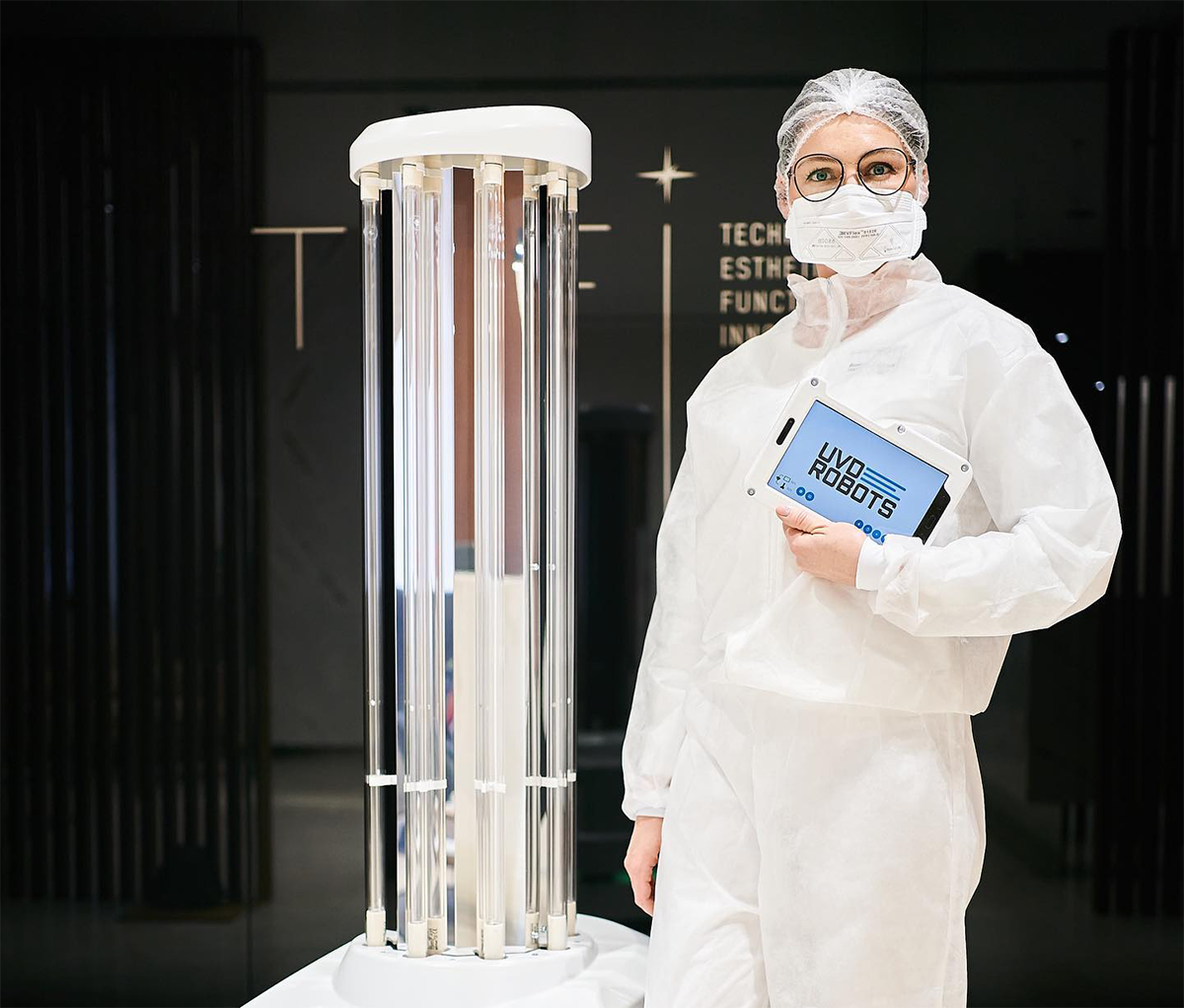
Businesses and facilities have long prioritized the cleanliness of their environments. However, relying solely on manual cleaning methods for cleanliness and disinfection can be laborious and susceptible to human error. That's where UVD Robots comes in, offering an invaluable addition to manual cleaning by introducing advanced technologies that enhance efficiency and effectiveness in maintaining a pristine and hygienic environment.
UVD Robots offers solutions for various sectors looking to enhance their disinfection procedures in conjunction with their manual cleaning methods. Using the most powerful and effective form of UV-C light, our robot attacks and destroys microorganisms - and has been shown to reduce bacterial counts on high-touch surfaces.
UVD Robots are fully autonomous and mobile robots that use UV-C light - and can disinfect large and small spaces. Our robots are more effective at creating cleaner environments than other automated UV disinfection devices or static systems. Through the use of UV-C light, the robot can mitigate microorganisms in environments at improved efficacy rates.
The robots may even save on capital costs as each system can service multiple areas of a facility.
1. Efficiency: One person can manage a small fleet of our UV-C disinfection robots, thanks to the full autonomy and short cycle time. This allows rooms to be disinfected quickly and efficiently, without the need for human interaction. Operating as a labor and time-saving measure, this can allow workers to focus on important tasks outside of cleaning and disinfection.
2. Consistency: A UVD Robot is able to disinfect a room consistently and thoroughly, applying an adequate treatment of UV-C light to all surfaces. Its UV-C light distribution methods ensure that the UV disinfection process is steady, even, and complete.
3. Effectiveness: UV-C light has shown to be an effective disinfectant - and by using a robot to deliver UV-C light, there is a greater chance of adequately disinfecting indoor room surface areas.
UVD Robots offer reliable and thorough UV light disinfection, and independent antimicrobial efficacy testing has shown that our UV-C disinfection methods can eliminate at least 99.99% of test-selected microorganisms. This is a higher efficacy rate than manual cleaning and disinfection methods alone, which often fail to eliminate all selected microorganisms such as C. difficile and Klebsiella pneumoniae. UVD Robots' full autonomy also reduces the risk of errors and labor costs, making it a valuable addition to manual cleaning and any business' cleaning process.
UVD Robots are 2.5 times faster than other solutions when it comes to environmental disinfection. This is because UVD Robots have 1,440 watts of UV-C light power. By comparison, other solutions operate at only 600 watts of power, potentially raising total disinfection times. For example, UVD Robots can disinfect an entire room in only 10 minutes - while it would take static solutions 25 minutes to do the same job.
This means that UVD Robots give you a better chance at saving time and labor in the disinfection process, with a 2-hour disinfection workflow. This is in comparison to the 5-hour workflows of other solutions. UVD Robots also have a Reflector System that helps maintain disinfection efficacy, while other solutions, without such systems, lose the effectiveness over time. All of these features help give UVD Robots an enhanced performance, disinfecting at least 2.5 times faster and more effectively than other solutions.
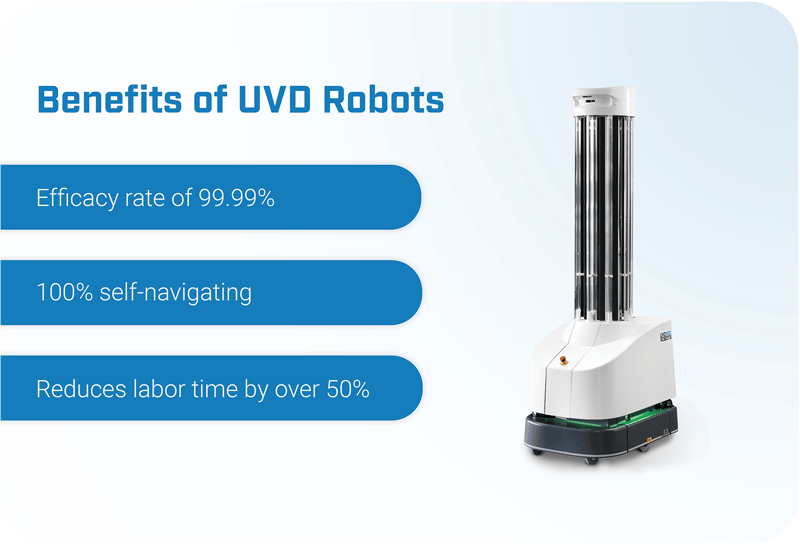
UVD Robots have been built with both high maneuverability and stability in mind, qualities not always found in other solutions. For example, other solutions may have weight distributions that might lead to instability during their cleaning operations.
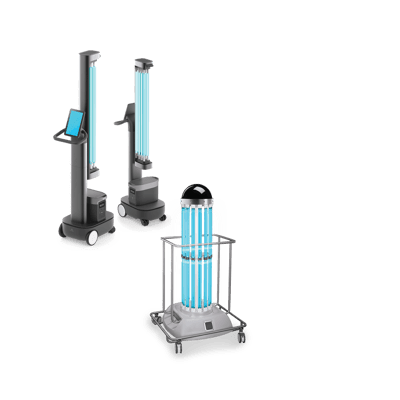
This distribution could produce risks of tipping over, or other mobility-related operational issues. Thus adding to the fact that those solutions might not be able to accommodate a thorough and steady UV light disinfection process.
The same goes when looking into maneuverability. As many other solutions are building their UV disinfection robots on static systems, users often experience an issue with having to physically move the robot between every disinfection - risking area contamination and increasing labor time. This is due to the fact that for the UV light to reach all corners of the room, a person will have to manually move the robot between disinfecting. When repositioning the static UV disinfection system, the operator might introduce microorganisms from outside of the room, risking contaminating the newly disinfected areas. The disinfection time for a room of 40 m2 takes on average 45-60 minutes when using a static UV disinfection system whereas using an autonomous UV disinfection system like UVD Robots it is possible to disinfect an entire room of 40 m2 in just 18-20 minutes.
When deciding on which UV light disinfection solution to choose, you should be aware of which UV lamps are used. UVD Robots have a 33% longer lamp lifetime than other solutions, resulting in a lower total cost of ownership. While other solutions' lamps last for 9,000 hours, UVD Robots' lamps last for 12,000 hours. In various settings, this means that UVD Robots can potentially help facilities save on lamp replacements.
Longer lamp lifetimes also mean that facilities can expect reliable and effective disinfection processes over longer periods of time. For all these reasons, UVD Robots offer cost-effective and reliable disinfection solutions for various environments.
If you're considering using UV-C light to disinfect your business or organization, you may be wondering whether to choose a static or an autonomous/self-driving solution. While static disinfection methods may initially be lower-cost upfront options, there are several favorable reasons to consider investing in technologies such as UVD Robots' autonomous disinfection solutions.
Here are some of them:
In essence, UVD Robots have been proven to be a superior UV light disinfection solution because of the robot’s efficiency, reliability, and cost-effectiveness. The robots are powerful tools for disinfection procedures, cleaning without the need for harsh chemicals or labor-intensive processes - making them a valuable investment for any facility or organization.
Want to learn more about the differences between static and autonomous UV disinfection robots? Check out the article on the topic here!
UVD Robots have been proven to be highly effective in disinfection procedures. The use of UV-C light for disinfection has been well-studied, and there is a wealth of information on the doses of UV light necessary to inactivate different microorganisms.
Microorganism reduction is classified through use of a logarithmic scale. A single log reduction represents a 90% reduction of microorganisms, while a Log2 reduction represents a reduction rate of 99%, and Log3 and Log4 reductions represent reduction rates of 99.9 and 99.99%, respectively.
Independent testing shows that UVD Robots' 254nm UV-C solution rapidly eliminates selected microorganisms like Clostridium difficile, E. coli and Staphylococcus Aureus at efficacy rates of 99.999%. This demonstrates that UVD Robots are highly effective at disinfecting surfaces and destroying microorganisms.
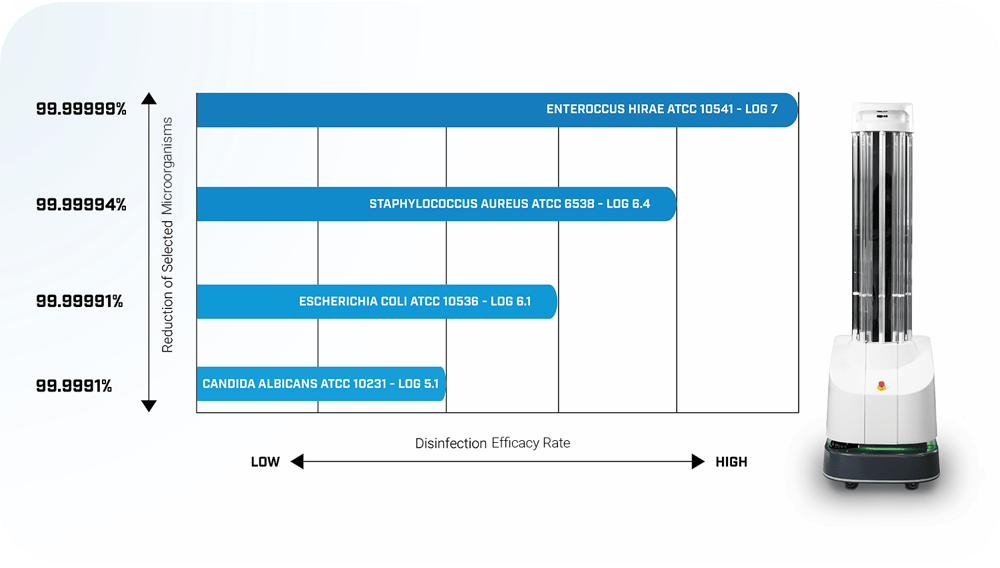
UVD Robots can get closer to target surfaces – and this helps disinfect these surfaces more efficiently than other methods. As UVD Robots move autonomously through a room, the UV-C lamps are able to get closer to surface areas than static devices, offering a more complete level of UV-C exposure. This means all surface areas can receive equal treatment, ensuring thorough disinfection.
The Inverse Square law applies to UV-C light exposure. The law states that energy levels reduce in intensity in proportion to the distance from an energy source. This reduction of energy is represented by inverting the square of the distance involved. For example, if a surface is 1 meter away from a light source, it might receive 1 watt per square radian (1 W/sr) of energy. If that same surface is 3 meters away, it will receive 1/9 watts per square radian (1/9 W/sr). This is the inverse of the square of the distance: 1 over 3 squared, or 1/9. In terms of UV-C disinfection, the closer a UV light source is to a surface, the more energy will be radiated to that surface. This will result in a more effective disinfection process. Because UVD Robots are autonomous, they can get closer to different surfaces, providing optimal doses of UV-C light for effective disinfection.
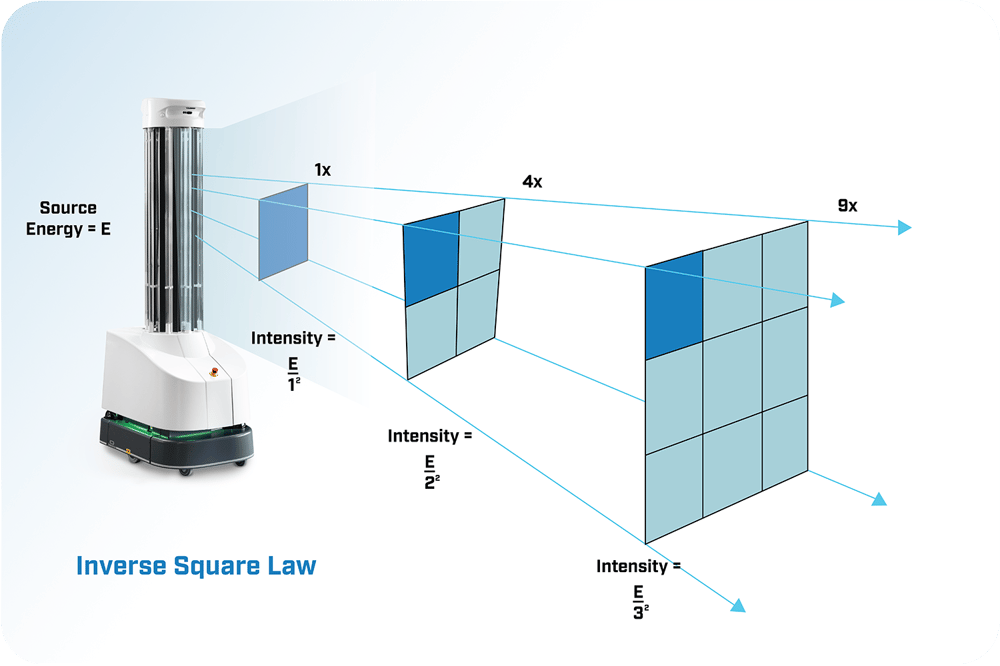
UVD Robots are a superior solution for disinfecting large areas when compared to static solutions. Unlike static disinfection systems, UVD Robots can move around different spaces, allowing UV-C light to be in close proximity to all target surfaces. This means that high levels of irradiance are available to all surfaces, ensuring thorough UV disinfection.
Furthermore, UVD Robots do not lose irradiating strength based on the Inverse Square Law. This means that the robots can deliver required doses for log3 reductions of selected microorganisms as the robots move past any given area. This makes UVD Robots an effective and efficient solution for disinfecting large spaces.
In contrast, static disinfection systems are limited in their ability to deliver consistent doses of irradiation to all surfaces. This can result in incomplete disinfection processes and can put people at risk of exposure to different microorganisms. Being autonomous, UVD Robots offer a more effective solution for large-scale disinfection.
Shadowing is a common issue with static UV-C disinfection systems, but it is easily overcome by using autonomous systems. Because UVD Robots are able to navigate through any space, we can deliver consistent doses of irradiation to all surfaces, eliminating hindrance from shadowed areas. This ensures thorough disinfection without any areas being left obscured.
Other autonomous UV-C units may require hours of labor and setup, and this can include actions like installing markers, identifying locations, testing and verifying sensors, identifying disinfection points, planning routes, optimizing mapped areas, and periods of extensive training.
In contrast, UVD Robots are easy to configure, deploy, and use. The robots’ user-centric design is highly accessible, and requires little to no upfront training. Besides saving on labor costs, it takes less than 5 minutes to map a 1,000 square foot rectangular space with a UVD Robot, making the robots a more efficient and user-friendly solution for disinfection.
UVD Robots report data that allows you to ensure a thorough UV light disinfection of any mapped area. After each session, users can view both reports and audit logs to ensure that their spaces have been properly disinfected. Automatic reports can also be sent to relevant stakeholders, providing an added assurance that static systems cannot offer. With UVD Robots, users can access valuable data and ensure the cleanliness of the environments.
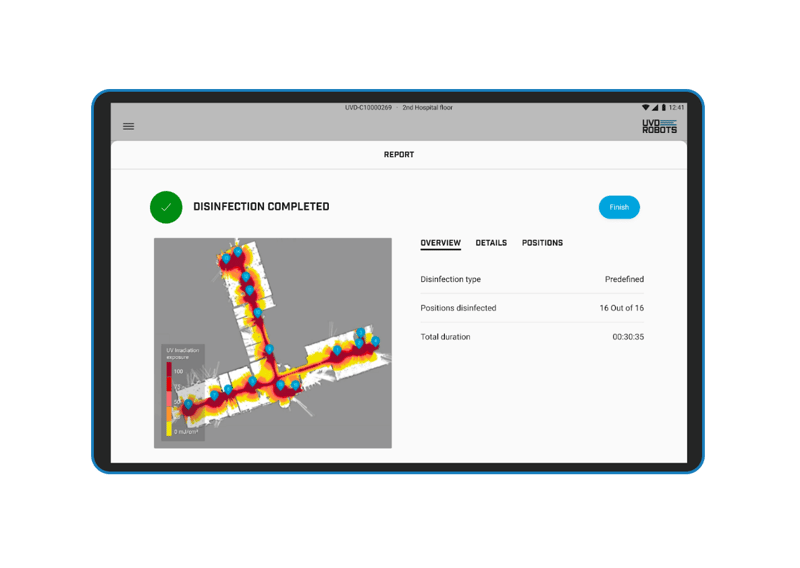
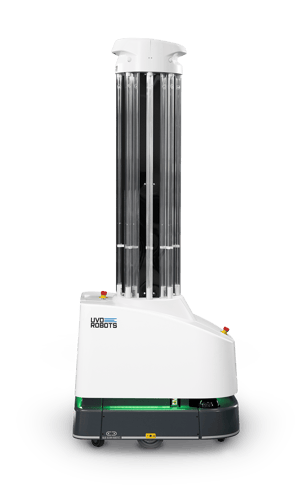
UVD Robots provide fully automated disinfection solutions with predictable, and cost effective outcomes in various facilities.
Click the button to learn how our UVD Robots are using UV-C light to eliminate more than 99.99% of selected microorganisms in the environment by disinfecting with UV-C light.